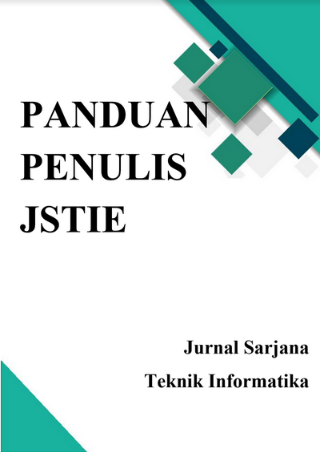SISTEM PAKAR UNTUK MENDIAGNOSA PENYAKIT HEPATITIS DENGAN METODE FUZZY TSUKAMOTO
DOI:
https://doi.org/10.12928/jstie.v2i2.2724Abstract
Penyakit hepatitis merupakan urutan pertama dari berbagai penyakit hepar diseluruh dunia. Virus hepatitis merupakan penyakit infeksi yang penyebarannya luas dalam tubuh walaupun efek yang menyolok terjadi pada hepar. Telah ditemukan 5 kategori virus yang menjadi agen penyebab yaitu Virus Hepatitis A (HAV), Virus Hepatitis B (HBV), Virus Hepatitis C (HVC), Virus Hepatitis D (HDV), Virus Hepatitis E (HEV). Infeksi virus hepatitis bisa berkembang menjadi sirosis atau pengerasan hepar bahkan kanker hepar. Masalahnya, sebagian besar infeksi hepatitis tidak menimbulkan gejala dan baru terasa 10-30 tahun kemudian saat infeksi sudah parah. Pentingnya mengetahui penyebab hepatitis bagi klien adalah apabila ada anggota keluarga menderita penyakit yang sama, supaya anggota keluarga dan klien siap menghadapi resiko terburuk dari penyakit hepatitis beserta komplikasinya sehingga penderita mampu menyiapkan diri dengan pencegahan dan pengobatan.
Pengembangan perangkat lunak sistem pakar ini meliputi, analisis kebutuhan perangkat lunak yang terdiri dari analisis kebutuhan user, analisis kebutuhan sistem dan perancangan rekayasa pengetahuan dimana dalam pembuatan rekayasa perangkat lunak ini data yang terkumpul direpresentasikan sebagai basis pengetahuan, basis aturan dan perancangan mesin inferensi dengan metode fuzzy tsukamoto. Selanjutnya perancangan sistem, yang merancang pembuatan pemodelan proses yang terdiri dari konteks diagram dan DFD, pemodelan data yang terdiri dari perancangan ERD, Mapping Table dan perancangan tabel. Pengembangan proses selanjutnya adalah implementasi menggunakan Visual Basic 6.0 dan tahap akhir pengembangan sistem yaitu pengujian dengan Black Box Test dan Alfa Test.
           Hasil penelitian berupa program aplikasi sistem pakar untuk mendiagnosa penyakit hepatitis dengan metode fuzzy tsukamoto. Keluaran sistem berupa hasil penelusuran penyakit yang dilengkapi nilai kepastian yang diperoleh dengan perhitungan menggunakan metode fuzzy tsukamoto, penyebab, pencegahan dan pengobatan.
Kata kunci : Sistem pakar, fuzzy tsukamoto, Penyakit HepatitisReferences
Ari Pujiantoro, 2012, Sistem Pakar Penentuan Jenis Penyakit Hati Dengan Metode Inferensi Fuzzy Tsukamoto, S-1, Universitas Ahmad Dahlan, Yogyakarta.
Bejo Santoso, 2008, Jaringan syaraf tiruan Backpropagation untuk diagnosa penyakit Hepatitis, S-1, Universitas Ahmad Dahlan, Yogyakarta.
Kusumadewi, Sri, 2002, Artifical Intelegence (Teknik dan Aplikasinya), Graha Ilmu, Yogyakarta.
Wijaya, Andi, 1990, Diagnosis Laboratorik Penyakit Hati (Program Pustaka Seri Hepatitis 03), Laboratorium Klinik Prodia, Jakarta.
Sulaiman, Ali, 1995, Virus Hepatitis A Sampai E Di Indonesia, Yayasan Penerbit Ikatan Dokter Indonesia, Jakarta.
Muhammad, Arhami, 2005, Konsep Dasar Sistem Pakar, Andi, Yogyakarta.
Pujiyanta, Ardi, 2010, Teori dan Aplikasi Fuzzy Logic, Ardana Media, Yogyakarta.
Tarmuji, Ali.,S.T., 2007, Diktat Rekayasa Perangkat Lunak, Teknik Informatika Universitas Ahmad Dahlan, Yogyakarta.
Downloads
Published
Issue
Section
License
License and Copyright Agreement
In submitting the manuscript to the journal, the authors certify that:
- They are authorized by their co-authors to enter into these arrangements.
- The work described has not been formally published before, except in the form of an abstract or as part of a published lecture, review, thesis, or overlay journal. Please also carefully read Journal Posting Your Article Policy.
- The work is not under consideration for publication elsewhere.
- The work has been approved by all the author(s) and by the responsible authorities – tacitly or explicitly – of the institutes where the work has been carried out.
- They secure the right to reproduce any material that has already been published or copyrighted elsewhere.
- They agree to the following license and copyright agreement.
Copyright
Authors who publish with Jurnal Sarjana Teknik Informatika agree to the following terms:
- Authors retain copyright and grant the journal right of first publication with the work simultaneously licensed under a Creative Commons Attribution License (CC BY-SA 4.0) that allows others to share the work with an acknowledgement of the work's authorship and initial publication in this journal.
- Authors are able to enter into separate, additional contractual arrangements for the non-exclusive distribution of the journal's published version of the work (e.g., post it to an institutional repository or publish it in a book), with an acknowledgement of its initial publication in this journal.
- Authors are permitted and encouraged to post their work online (e.g., in institutional repositories or on their website) prior to and during the submission process, as it can lead to productive exchanges, as well as earlier and greater citation of published work.







